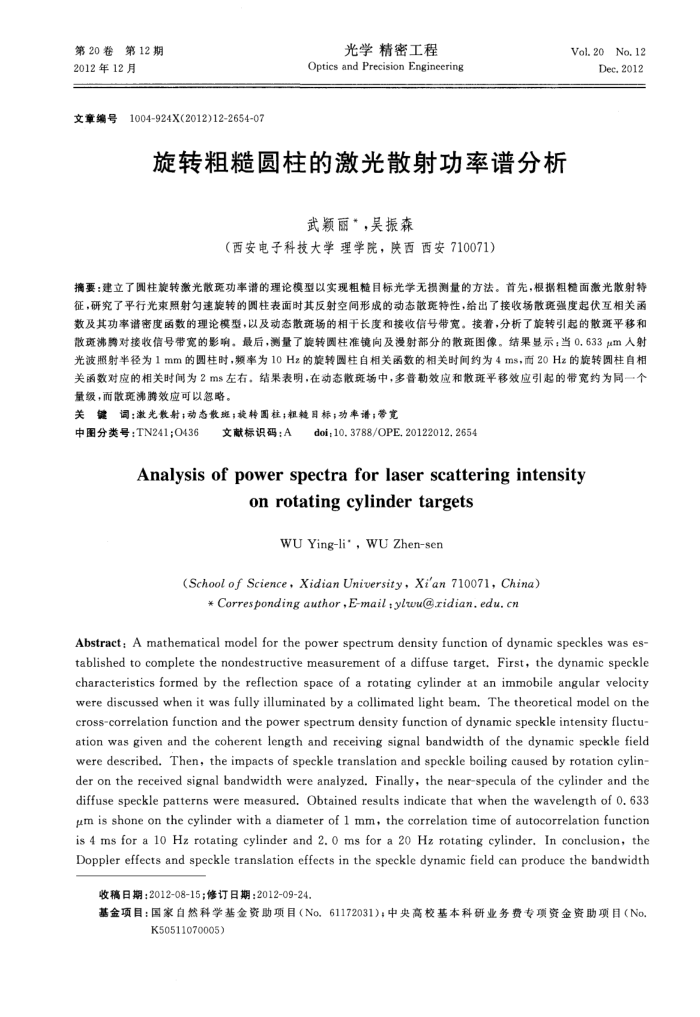您当前的位置:首页>论文资料>旋转粗糙圆柱的激光散射功率谱分析
内容简介
 第20卷第12期 2012年12月
第20卷第12期 2012年12月文章编号
1004924X(2012)12-2654-07
光学精密工程
Optics and Precision Engineering
旋转粗糙圆柱的激光散射功率谱分析
武颖丽*,昊振森
(西安电子科技大学理学院,陕西西安710071)
Vol.20No.12
Dec.2012
摘要:建立了圆柱旋转激光散班功率谱的理论模型以实现粗糙目标光学无损测量的方法。首先,根据粗糙面激光散射特征,研究了平行光束照射勾速旋转的圆柱表面时其反射空间形成的动态散斑特性,给出了接收场散班强度起伏互相关函数及其功率谱密度函数的理论模型,以及动态散斑场的相干长度和接收信号带宽。接着,分析了旋转引起的散斑平移和散斑沸腾对接收信号带宽的影响。最后,测量了旋转圆柱准镜向及漫射部分的散斑图像。结果显示;当0.633μm人射光波照射半径为1mm的圆柱时,频率为10Hz的旋转圆柱自相关函数的相关时间约为4ms,而20Hz的旋转圆柱自相关函数对应的相关时间为2ms左右,结果表明,在动态散斑场中,多普勒效应和散斑班平移效应引起的带宽约为同一个量级,而散斑沸腾效应可以忽略。
关键词:激光散射;动态散斑;换转围柱;租较目标;功率谱;带宽
中图分类号:TN241;O436
文献标识码:A
doi;10.3788/OPE,20122012.2654
Analysisofpowerspectraforlaserscatteringintensity
onrotatingcylindertargets
WUYing-li',WUZhen-sen
(SchoolofScience,XidianUniversity,Xian710071,China
*Correspondingauthor,E-mail:ylwu@.ridian.edu.cn
Abstract: A mathematical model for the power spectrum density function of dynamic speckles was es-tablished to complete the nondestructive measurement of a diffuse target. First, the dynamic speckle characteristics formed by the reflection space of a rotating cylinder at an immobile angular velocity were discussed when it was fully illuminated by a collimated light beam, The theoretical model on the cross-correlation function and the power spectrum density function of dynamic speckle intensity fluctu ation was given and the coherent length and receiving signal bandwidth of the dynamic speckle field were described. Then, the impacts of speckle translation and speckle boiling caused by rotation cylin-der on the received signal bandwidth were analyzed. Finally, the near-specula of the cylinder and the diffuse speckle patterns were measured. Obtained results indicate that when the wavelength of o. 633 μm is shone on the cylinder with a diameter of 1 mm, the correlation time of autocorrelation function is 4 ms for a 1o Hz rotating cylinder and 2. 0 ms for a 2o Hz rotating cylinder. In conclusion, the Doppler effects and speckle translation effects in the speckle dynamic field can produce the bandwidth
收稿日期:2012-08-15;修订日期:2012-09-24.
基金项目:国家自然科学基金资助项目(No.61172031);中央高校基本科研业务费专项资金资助项目(No.
K50511070005)
上一章:图像拼接方法综述
下一章:三旋光结构一步无进位加法器的设计